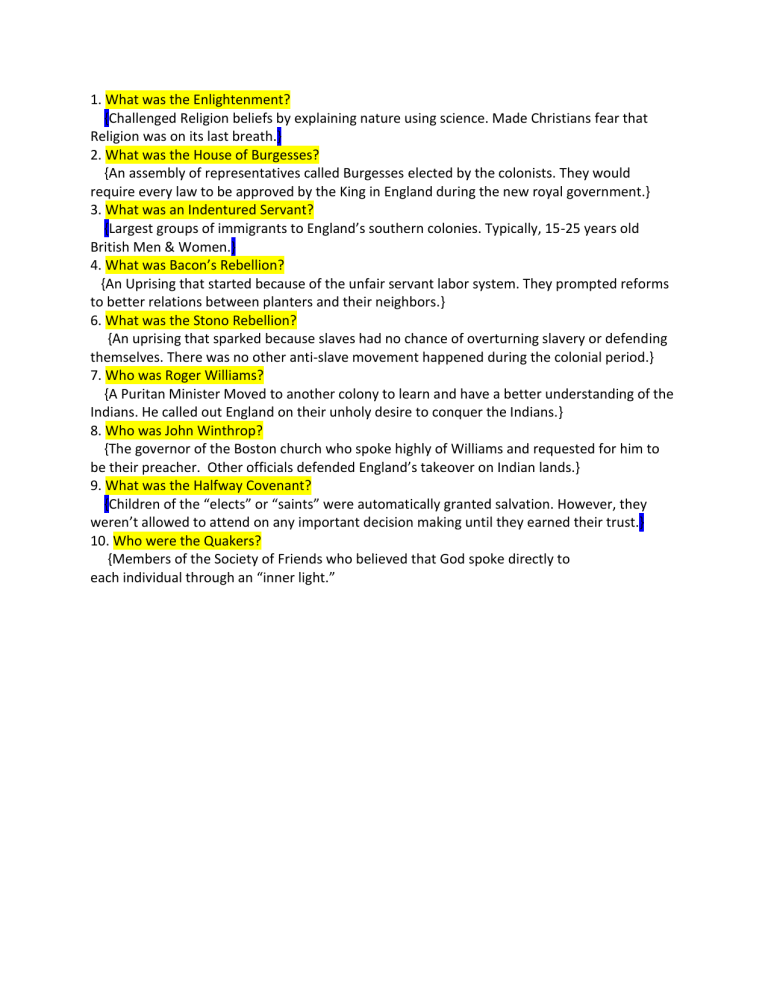
1. What was the Enlightenment?
{Challenged Religion beliefs by explaining nature using science. Made Christians fear that
Religion was on its last breath.}
2. What was the House of Burgesses?
{An assembly of representatives called Burgesses elected by the colonists. They would
require every law to be approved by the King in England during the new royal government.}
3. What was an Indentured Servant?
{Largest groups of immigrants to England’s southern colonies. Typically, 15-25 years old
British Men & Women.}
4. What was Bacon’s Rebellion?
{An Uprising that started because of the unfair servant labor system. They prompted reforms
to better relations between planters and their neighbors.}
6. What was the Stono Rebellion?
{An uprising that sparked because slaves had no chance of overturning slavery or defending
themselves. There was no other anti-slave movement happened during the colonial period.}
7. Who was Roger Williams?
{A Puritan Minister Moved to another colony to learn and have a better understanding of the
Indians. He called out England on their unholy desire to conquer the Indians.}
8. Who was John Winthrop?
{The governor of the Boston church who spoke highly of Williams and requested for him to
be their preacher. Other officials defended England’s takeover on Indian lands.}
9. What was the Halfway Covenant?
{Children of the “elects” or “saints” were automatically granted salvation. However, they
weren’t allowed to attend on any important decision making until they earned their trust.}
10. Who were the Quakers?
{Members of the Society of Friends who believed that God spoke directly to
each individual through an “inner light.”
11. What was Predestination?
{The church would select a few “elect” or “saints” to be saved. Others who weren’t given
salvation were dammed on birth and had no hopes of changing their fates.}
12. What were the Presidios?
{Forts that were built to prevent Russian Access.
13. What was the Mayflower compact
{To provide order and security they drew up the mayflower compact on the day they
arrived. The signers were all only men who agreed to obey the laws.}
14. What was the Act of Supremacy?
{King Henry VII wanted the church’s blessings given based purely off of his royalty. After
being denied he made laws that granted him powers of religion and outlawed the Catholic
church.}
15. Who was Anne Hutchinson?
{A Puritan woman who’s a mother of fourteen children. She would preach at home about
the “Covenant of Grace.”}
16. Who was Olaudah Equiano?
{A man who was captured as a slave since he was eleven years old. He later released a
publishing describing all the details of his enslavement.}
17. Redemptioner
{Borrowed money from friend or family to travel across seas. Many
of them traveled in groups consisting of family members.}
18. What was the Great Awakening?
{Wave of revivals that spread through the colonies
in the 1730s and 1740s.
19. What was the Middle Passage?
{A popular route where slaves were taken by boat to be traded. Many would die during the
trip.}
20. What was the Halfway Covenant?
{Children of the “elects” or “saints” were automatically granted salvation. However, they
weren’t allowed to attend on any important decision making until they earned their trust.}
Describe the key features of the British North Americans colonies and the unifying experiences
they all share?
British American colonies had an Insane population growth going from 250,000 to 2 million in a
short spawn of just 70 years.
Immigration made up of one-fourth (or ¼) of the population increase.
This major population increase also expanded their economy.
The abundance of land made labor precious, and the colonists always needed more.
The bottomless demand for labor was the fundamental economic environment that sustained
the mushrooming population.
The New England population grew sixfold but lagged behind the growth in other colonies.
Most immigrants choose other destinations due to Puritan orthodox discouraging newcomers
of other faith.
The New England population grew mostly by natural increase, much as it had during the
seventeenth century.
The perils of childbirth gave wives a shorter life expectancy than husbands, but wives often
lived to have six, seven, or eight babies.
The growing New England population pressed against a limited amount of land






